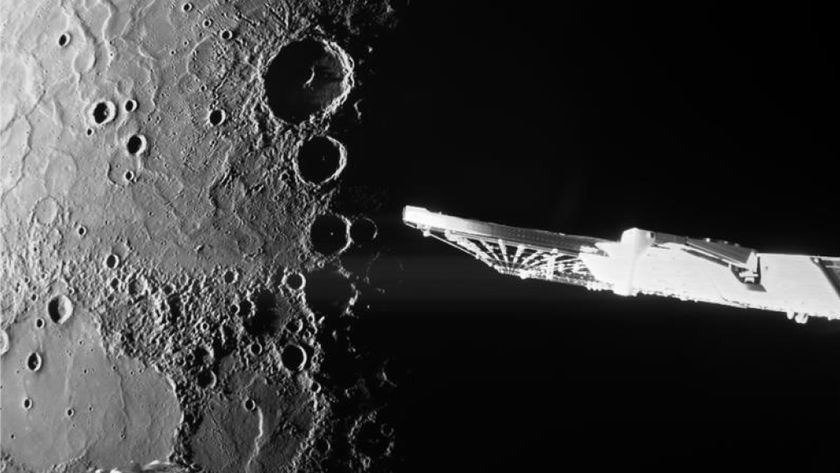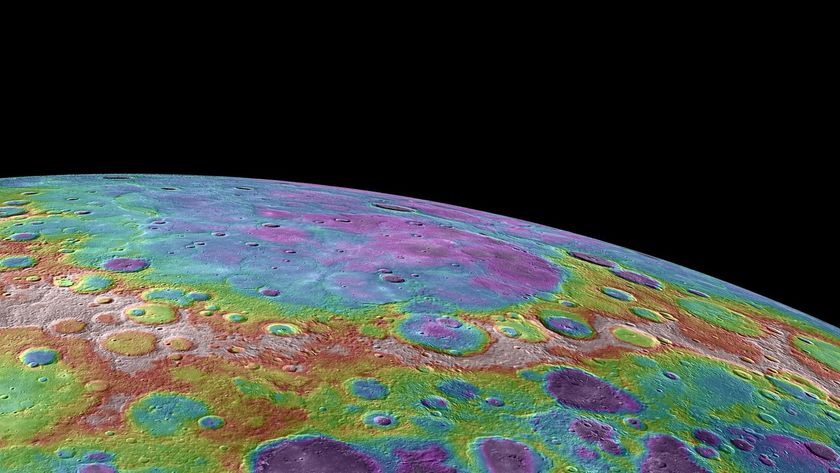Space Probe Swings by Mercury
LAUREL, Md. - For the first time in 33 years, a space probe zoomed by the planet Mercury with cameras blazing on Monday while eager scientists looked on from Earth.
NASA?s MESSENGER spacecraft successfully flew past its target planet at 2:04:39 p.m. EST (1904:39 GMT) as applause filled its mission control room here at the Johns Hopkins University Applied Physics Laboratory.
?It went right according to script, so that was very comforting,? MESSENGER principal investigator Sean Solomon, of the Carnegie Institution of Washington, told SPACE.com after the flyby.
MESSENGER - short for MErcury Surface, Space ENvironment, GEochemistry, and Ranging - skimmed just 124 miles (200 km) over the surface of its target planet during the first of three planned flybys to guide the spacecraft toward an eventual orbit around the small rocky world on March 18, 2011.
Not since NASA?s Mariner 10 probe, which flew past Mercury three times between 1974 and 1975, has a spacecraft taken such a close look at the planet. Researchers hope MESSENGER?s $446 million mission will answer long-standing questions over Mercury?s oddly high density, magnetic field and thin atmosphere, as well as shed new light on how planets formed during the solar system?s infancy.
?To understand the excitement of the scientists, you have to think of this as the first Super Bowl in 30 years,? said Marilyn Lindstrom, NASA?s MESSENGER program scientist, before the flyby. ?We?ve been waiting to go back to Mercury that long.?
Mariner 10, for example, only mapped about 45 percent of Mercury?s surface during its three flybys. MESSENGER turned its cameras and other instruments on half of the planet?s uncharted surface during today?s flyby and will ultimately spend an entire year in orbit around the planet.
Sign up for the Live Science daily newsletter now
Get the world’s most fascinating discoveries delivered straight to your inbox.
?The real question is, ?Does it all look the same??? said Rob Gold, MESSENGER?s science payload manager at the Applied Physics Laboratory. ?We just don?t know.?
If all goes well, MESSENGER will begin beaming more than 1,200 new images of Mercury back to Earth along with other data around midday tomorrow.
Mark Robinson, a science team member from the University of Arizona, said he is looking forward to MESSENGER?s views of the Caloris Basin, a large impact crater that Mariner 10 only saw half of during its flight.
?They are imaging, basically, the largest single unexplored piece of real estate in the inner solar system,? Alan Stern, associate administrator for NASA?s science mission directorate, told reporters today.
A vital sunshade, just one example of advances in technology between the Mariner 10 and MESSENGER missions, allows the new probe to keep its sophisticated instruments at about room temperature while the sun-facing side reaches a scorching 600 degrees Fahrenheit (315 degrees Celsius).
?It?s like taking a 2008 Jaguar and comparing it to a six-year-old?s toy bike,? Stern said of the improvements since Mariner 10.
Mission scientists said they are already planning MESSENGER?s next Mercury flyby, set for October, and expect the spacecraft to finish relaying all of the imagery and other data from today?s rendezvous by next week.
?I will be just simply chomping at the bit to see data that come down,? said Faith Vilas, a MESSENGER participating scientist and director of the MMT Observatory in Mt. Hopkins, Ariz.
MESSENGER was expected to swing by Mercury at a speed of about 16,000 mph (25,749 kph) and use the planet's gravitational pull to slow down by about 5,000 mph (8,046 kph). It has completed just over half of its 4.9 billion-mile (7.9 billion-kilometer) flight to orbit Mercury.
Monday?s flyby marked the fourth planetary pass for MESSENGER, which has swung past Earth once and Venus twice since its August 2004 launch. The success of those previous flybys gave mission controllers vital experience for today?s rendezvous, mission researchers said.
?They made it look easy,? Solomon said.

Tariq is the editor-in-chief of Live Science's sister site Space.com. He joined the team in 2001 as a staff writer, and later editor, focusing on human spaceflight, exploration and space science. Before joining Space.com, Tariq was a staff reporter for The Los Angeles Times, covering education and city beats in La Habra, Fullerton and Huntington Beach. He is also an Eagle Scout (yes, he has the Space Exploration merit badge) and went to Space Camp four times. He has journalism degrees from the University of Southern California and New York University.











